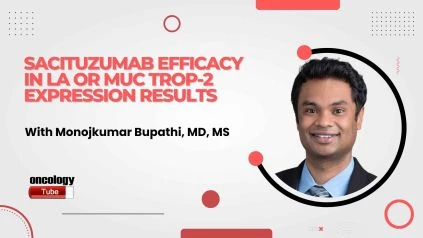Manojkumar Bupathi, MD, from the Rocky Mountain Cancer Centers, conducted a study to evaluate the effectiveness of sacituzumab govitecan (SG) in patients with locally advanced (LA) or metastatic urothelial cancer (mUC) based on the expression of trophoblast cell surface antigen 2 (Trop-2).
The study aimed to determine if Trop-2 expression levels could predict response to treatment.
Trop-2 is a glycoprotein that is often highly expressed in various cancers, including urothelial cancer.
SG is an antibody-drug conjugate that specifically targets Trop-2.
It has been approved by the FDA for use in patients with LA unresectable or mUC who have previously received platinum and a checkpoint inhibitor.
Previous phase 2 trials (TROPHY-U-01) have shown promising results, with objective response rates (ORR) of 28% in Cohort 1, 32% in Cohort 2, and 41% in Cohort 3.
The study enrolled patients aged 18 and older who had previously received platinum, a checkpoint inhibitor, or both.
SG was administered intravenously at a dose of 10 mg/kg on Day 1 and Day 8 of 21-day cycles. Patients in Cohort 3 also received pembrolizumab.
The primary endpoint was the ORR as assessed by independent review.
Archival tumor samples were collected at enrollment and analyzed for Trop-2 expression using immunohistochemistry (IHC).
A total of 192 patients were enrolled in Cohorts 1-3, with 144 patients (75%) having samples suitable for Trop-2 evaluation.
The baseline characteristics of the patients with evaluable samples were consistent with the overall population.
Trop-2 expression levels were assessed using histological scores (H-scores) and the percentage of membrane-positive tumor cells.
The results showed that Trop-2 protein was highly expressed across all cohorts.
However, there was no significant difference in ORR, progression-free survival (PFS), or overall survival (OS) between patients with Trop-2 H-scores below or above the median.
Similar findings were observed when evaluating Trop-2 membrane positivity.
These results suggest that the efficacy of SG may be independent of Trop-2 expression in urothelial cancer.
Although the study provides insights into Trop-2 expression in urothelial cancer and its association with SG efficacy, further research is needed to confirm these findings.
The analysis of archival tumor samples supports previous studies on Trop-2 expression in urothelial cancer and highlights the need for additional investigations to better understand the role of Trop-2 as a predictive biomarker.
In conclusion, Dr. Bupathi’s study demonstrated that Trop-2 protein was highly expressed in patients with previously treated LA or mUC.
The efficacy of SG treatment did not significantly differ based on Trop-2 expression levels.
These findings suggest that SG may have activity independent of Trop-2 expression in urothelial cancer. Further clinical studies are warranted to validate these results.

